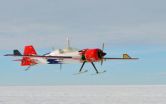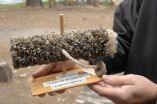(Press-News.org) PROVIDENCE, R.I. [Brown University] — The surface of Mercury crackled with volcanic explosions for extended periods of the planet's history, according to a new analysis led by researchers at Brown University. The findings are surprising considering Mercury wasn't supposed to have explosive volcanism in the first place, and they could have implications for understanding how Mercury formed.
On Earth, volcanic explosions like the one that tore the lid off Mount St. Helens happen because our planet's interior is rich in volatiles — water, carbon dioxide and other compounds with relatively low boiling points. As lava rises from the depths toward the surface, volatiles dissolved within it change phase from liquid to gas, expanding in the process. The pressure of that expansion can cause the crust above to burst like an overinflated balloon.
Mercury, however, was long thought to be bone dry when it comes to volatiles, and without volatiles there can't be explosive volcanism. But that view started to change in 2008, after NASA's MESSENGER spacecraft made its first flybys of Mercury. Those glimpses of the surface revealed deposits of pyroclastic ash — the telltale signs of volcanic explosions — peppering the planet's surface. It was a clue that at some point in its history Mercury's interior wasn't as bereft of volatiles as had been assumed.
What wasn't clear from those initial flybys was the timeframe over which those explosions occurred. Did Mercury's volatiles escape in a flurry of explosions early in the planet's history or has Mercury held on to its volatiles over a much longer period?
This latest work, available in online early view at the Journal of Geophysical Research: Planets, suggests the latter.
A team of researchers led by Tim Goudge, a graduate student in the Department of Geological Sciences at Brown, looked at 51 pyroclastic sites distributed across Mercury's surface. They used data from MESSENGER's cameras and spectrometers collected after the spacecraft entered orbit around Mercury in 2011. Compared with the data from the initial flybys, the orbital data provided a much more detailed view of the deposits and the source vents that spat them out.
The new MESSENGER data revealed that some of the vents have eroded to a much greater degree than others — an indicator that the explosions didn't happen all at the same time.
"If [the explosions] happened over a brief period and then stopped, you'd expect all the vents to be degraded by approximately the same amount," Goudge said. "We don't see that; we see different degradation states. So the eruptions appear to have been taking place over an appreciable period of Mercury's history."
But just where that period of explosiveness fits into Mercury's geological history was another matter. To help figure that out, Goudge and his colleagues took advantage of the fact that most of the sites are located within impact craters. The age of each crater offers an important constraint in the age of the pyroclastic deposit inside it: The deposit has to be younger than its host crater. If the deposit had come first, it would have been obliterated by the impact that formed the crater. So the age of the crater provides an upper limit on how old the pyroclastic deposit can be.
As it happens, there's an established method for dating craters on Mercury. The rims and walls of craters become eroded and degraded over time, and the extent of that degradation can be used to get an approximate age of the crater.
Using that method, Goudge and his colleagues showed that some pyroclastic deposits are found in relatively young (geologically speaking) craters dated to between 3.5 and 1 billion years old. The finding helps rule out the possibility that all the pyroclastic activity happened shortly after Mercury's formation around 4.5 billion years ago.
"These ages tell us that Mercury didn't degas all of its volatiles very early," Goudge said. "It kept some of its volatiles around to more recent geological times."
The extent to which Mercury's volatiles stuck around could shed light on how the planet formed. Despite being the smallest planet in the solar system (since Pluto was demoted from the ranks of the planets), Mercury has an abnormally large iron core. That finding led to speculation the perhaps Mercury was once much larger, but had its outer layers removed — either fried away by the nearby Sun or perhaps blasted away be a huge impact early in the planet's history. Either of those events, however, would likely have heated the outer parts of Mercury enough to remove volatiles very early in its history.
In light of this study and other data collected by MESSENGER showing traces of the volatiles sulfur, potassium, and sodium on Mercury's surface, both those scenarios seem increasingly unlikely.
"Together with other results that suggest the Moon may have had more volatiles than previously thought, this research is revolutionizing our thinking about the early history of the planets and satellites," said Jim Head, professor of geological sciences and a MESSENGER mission co-investigator. "These results define specific targets for future exploration of Mercury by orbiting and landed spacecraft."
INFORMATION:
Editors: Brown University has a fiber link television studio available for domestic and international live and taped interviews, and maintains an ISDN line for radio interviews. For more information, call (401) 863-2476.
Ancient volcanic explosions shed light on Mercury's origins
2014-04-02
ELSE PRESS RELEASES FROM THIS DATE:
Unplanned pregnancy remains high among young Australian women
2014-04-02
Despite high rates of contraceptive use, unwanted pregnancies resulting in terminations remain high among young women.
In an article in the April issue of the Australian and New Zealand Journal of Public Health, Danielle Mazza from Monash University, and colleagues, examine the paradox of high rates of contraceptive use, over the counter availability of emergency contraception and unplanned pregnancy.
"The emergency contraceptive pill has been available to women for over-the-counter purchase since 2004," Professor Mazza said.
"Together with high rates of contraceptive ...
French, American team finds regolith of small asteroids formed by thermal fatigue
2014-04-02
The centimeter-sized fragments and smaller particles that make up the regolith — the layer of loose, unconsolidated rock and dust — of small asteroids is formed by temperature cycling that breaks down rock in a process called thermal fatigue, according to a paper published today in the Nature Advance Online Publication.
Previous studies suggested that the regolith of asteroids one kilometer wide and smaller was made from material falling to the surface after impacts and from boulders that were pulverized by micrometeoroid impacts. Recent laboratory experiments and impact ...
Team identifies novel biomarker for head and neck cancer, non-small cell lung cancer
2014-04-02
JUPITER, FL, April 2, 2014 – A team led by a scientist from the Florida campus of The Scripps Research Institute (TSRI) has identified a new biomarker linked to better outcomes of patients with head and neck cancers and non-small cell lung cancer. The work could help scientists develop new diagnostics and therapies and help physicians determine the best long-term treatments for patients with these cancers.
The findings, which were published this week online ahead of print by the journal Cancer, focus on a protein called Choline phosphate cytidylyltransferase-α CCT-α ...
Going global
2014-04-02
KANSAS CITY, MO - In textbooks, the grand-finale of cell division is the tug-of-war fought inside dividing cells as duplicated pairs of chromosomes get dragged in opposite directions into daughter cells. This process, called mitosis, is visually stunning to observe under a microscope. Equally stunning to cell biologists are the preparatory steps cells take to ensure that the process occurs safely.
Molecular biologists define those "cell cycle" steps as: G1, when cells survey chromosomes for damage and, if they pass muster, prepare to replicate them; S phase, in which ...
New model shows moderate resource use & reduced economic inequality keys to sustainability
2014-04-02
COLLEGE PARK, MD - A new analytical tool adds human factors to a widely-used biological model of how animal populations interact, suggesting that human societies can reach a steady state that is sustainable when they do not over-deplete natural resources and avoid extreme economic inequality.
The paper, titled "Human and nature dynamics (HANDY): modeling inequality and use of resources in the collapse or sustainability of societies," was published in the May 2014 issue of the journal Ecological Economics. Its authors are Safa Motesharrei, a Ph.D. candidate in applied ...
One or 2? How to decide how many species you have got
2014-04-02
It is often difficult to decide whether two animals belong to the same or two distinct species. This can be especially challenging for animals which externally look very similar. In a recent study, published in the open access journal Zoosystematics and Evolution, scientists from the Museum für Naturkunde Berlin use genetic data and sound analysis to test if treefrogs from West and Central Africa belong to different or the same species.
Due to the fact that, when external characters are used, only size is useful to distinguish these frogs the scientists employed additional ...
Remotely operated aircraft successfully tested as tool for measuring changes in polar ice sheets
2014-04-02
Scientists studying the behavior of the world's ice sheets--and the future implications of ice sheet behavior for global sea-level rise--may soon have a new airborne tool that will allow radar measurements that previously would have been prohibitively expensive or difficult to carry out with manned aircraft.
In a paper published in the March/ April edition of IEEE Geoscience and Remote Sensing Magazine, researchers at the Center for Remote Sensing of Ice Sheets (CReSIS) at the University of Kansas noted that they have successfully tested the use of a compact radar system ...
Don't move a mussel (or a clam, or a snail)
2014-04-02
(Millbrook, NY) Anyone that has spent time at a seaside pier has witnessed the destruction barnacles wreak on boat hulls. But biofouling animals are not limited to marine environments. A new paper published in the journal Frontiers in Ecology and the Environment estimates that the global management of freshwater mussels, clams, and other clinging animals costs $277 million U.S. dollars annually.
Biofoulers are organisms that accumulate underwater on hard surfaces, to the detriment of property and economically important activities, such as shipping, power generation, ...
Beyond proficiency: How early English exposure influences non-native speakers
2014-04-02
PRINCETON, N.J.—Non-native speakers exposed to English before moving to America are more likely to use the language in their daily lives in the United States, according to a report led by Princeton University's Woodrow Wilson School of Public and International Affairs.
Such early exposure – through newspapers, books, TV and classes as well as traveling – may help determine an immigrant's socioeconomic mobility, as English proficiency is strongly tied to cultural and social assimilation. The report, featured in the journal Social Science Research, is one of the first ...
Americans using more energy according to Lawrence Livermore analysis
2014-04-02
Americans used more renewable, fossil and even nuclear energy in 2013, according to the most recent energy flow charts released by Lawrence Livermore National Laboratory.
Each year, the Laboratory releases energy flow charts that illustrate the nation's consumption and use of energy. Overall, Americans used 2.3 quadrillion thermal units more in 2013 than the previous year.
The Laboratory also has released a companion chart illustrating the nation's energy-related carbon dioxide emissions. Americans' carbon dioxide emissions increased to 5,390 million metric tons, ...





